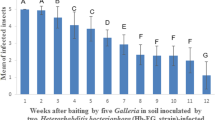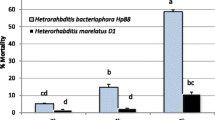Abstract
Purpose
Heterorhabdits indica successfully controlled apple root borer Dorysthenes huegelii in the orchards, but nematode-infected cadavers revealed the presence of non-symbiotic bacterial B. subtilis and B. licheniformis, and no subsequent generations of H. indica were produced (hampered recycling phenomenon). Intrigued, we tested the effect of the two Bacillus species on symbiotic association of H. indica—Photorhabdus luminescens.
Methods
One-to-one competitive parallel line in vitro assays were carried out between P. luminescens and the two Bacillus spp., while in vivo H. indica development was studied on the test insect Galleria mellonella which were fed with Bacillus mixed diet, followed by nematode exposure.
Results
Where P. luminescens was flanked by either of the two Bacillus species, only B. subtilis significantly suppressed its growth, while in reversed assays both the Bacillus growth was unaffected. Heterorhabditis indica was able to kill Galleria larvae pre-fed with the two Bacillus spp.; these cadavers did not develop the characteristic evenly distributed brick red coloration. Besides P. luminesecns, both Bacillus spp. were found to coexist in these cadavers. Development of hermaphrodites was not affected, but second-generation females, and final nematode progeny was reduced significantly. Monozenic lawns of B. subtilis and B. licheniformis did not support H. indica development.
Conclusion
These results show the reduced development of H. indica by the presence of the non-symbiotic bacteria in G. mellonella is likely to affect their ability to recycle in other insect larvae. Reduced recycling caused by non-symbiotic bacteria will reduce the overall long-term pest control benefits and have implications in the development of application strategies using entomopathogenic nematodes (EPNs) as insect control agents.






Similar content being viewed by others
References
Grewal PS, Ehlers RU, Shapiro-Ilan DI (2006) Nematodes as biocontrol agents. CABI Publishing, Oxon
Forst S, Nealson K (1996) Molecular biology of the symbiotic–pathogenic bacteria Xenorhabdus spp. and Photorhabdus spp. Microbiol Rev 60:1–43
Forst SA, Dowds BCA, Boemare NE, Stackebrandt E (1997) Xenorhabdus and Photorhabdus spp.: bugs that kill bugs. Ann Rev Microbiol. https://doi.org/10.1146/annurev.micro.51.1.47
Mohan S, Upadhyay A, Shrivastav A, Sreedevi K (2017) Implantation of Heterorhabditis indica-infected Galleria cadavers in soil for biocontrol of white grub infestation in sugarcane fields of Western Uttar Pradesh. Curr Sci 112(10):2016–2020
Lacey LA, Georgis R (2012) Entomopathogenic nematodes for control of insect pests above and below ground with comments on commercial production. J Nematol. https://doi.org/10.1016/j.biocontrol.2005.11.005
Mohan S, Upadhyay A, Khajuria DR (2017) Susceptibility of Heterohrhabditis indica and Steinernema abbassi to pre and post overwintering stages of apple root borer. Ann Plant Prot Sci 25(2):449–451
Shapiro-Ilan DI, Gaugler R, Tedders WL, Brown I et al (2002) Optimization of inoculation for in vivo production of entomopathogenic nematodes. J Nematol 34:343–350
Nielsen O, Philipsen H (2004) Seasonal population dynamics of inoculated and indigenous steinernematid nematodes in an organic cropping system. Nematology 6:901–909
Susurluk A, Ehlers RU (2008) Field persistence of the entomopathogenic nematode Heterorhabditis bacteriophora in different crops. Biol Control 53(627):641
Harvey CD, Alameen KM, Griffin CT (2012) The impact of entomopathogenic nematodes on a non–target, service–providing long horn beetle is limited by targeted application when controlling forestry pest Hylobius abietis. Biol Control 62:173–182
Hodson AK, Siegel JP, Lewis EE (2012) Ecological influence of the entomopathogenic nematode, Steinernema carpocapsae, on pistachio orchard soil arthropods. Pedobiologia 55:51–58
Brown IM, Gaugler R (1996) Cold tolerance of steinernematid and heterorhabitid nematodes. J Therm Biol 21:115–121
Kaya HK (2002) Natural enemies and other antagonists. In: Gaugler R (ed) Entomopathogenic nematology. CAB International, Wallingford, pp 189–203
Wollenberg AC, Jagdish T, Slough G, Hoinville ME, Wollenberg MS (2016) Death becomes them: bacterial community dynamics and stilbene antibiotic production in Galleria mellonella cadavers killed by Heterorhabditis/Photorhabdus. Appl Environ Microbiol 82(19):5824–5837
Cambon MC, Lafont P, Frayssinet M, Lanois A et al (2020) Bacterial community profile after the lethal infection of Steinernema-Xenorhabdus pairs into soil-reared Tenebrio molitor larvae. FEMS Microbiol Ecol. https://doi.org/10.1093/femsec/fiaa009
Ogier JC, Pagès S, Frayssinet M et al (2020) Entomopathogenic nematode-associated microbiota: from monoxenic paradigm to pathobiome. Microbiome. https://doi.org/10.1186/s40168-020-00800-5
Upadhyay A, Mohan S (2020) In-vivo production of EPNs suppressed by asymptomatic bacterial contaminants. Nematology. https://doi.org/10.1163/15685411-bja10001
Upadhyay A, Banakar P, Mohan S (2019) 16S rDNA based identification of non-symbiotic bacteria isolated from H. indica cuticle and infected G. mellonella and D. huegelii cadavers. Indian J Nematol 49(1):91–96
Mohan S, Upadhyay A, Banakar P, Rao U (2013) Molecular characterization of an indigenous isolate of Heterorhabditis pathogenic to white grubs. Proceeding of national symposium on nematode: a friend and foe of agri-horticultural crops 2013 November 21–23. YSP University, Solan, HP, pp-48.
Akhurst RJ (1980) Morphological and functional dimorphism in Xenorhabdus spp., bacteria symbiotically associated with the insect pathogenic nematodes Neoaplectana and Heterorhabditis. J Gener Microbiol. https://doi.org/10.1099/00221287-121-2-303
Han RC, Ehlers RU (2001) Effect of Photorhabdus luminescens phase variants on the in vivo and in vitro development and reproduction of the entomopathogenic nematodes Heterorhabditis bacteriophora and Steinernema carpocapsae. FEMS Microbiol Ecol 35:239–247
Lunau S, Schmidt-Peisker AL, Ehlers RU (1993) Establishment of monoxenic inocula for scaling up in vitro cultures of the entomopathogenic nematodes Steinernema spp. and Heterorhabditis spp. Nematologica 39:385–399
Jarosz J (1996) Ecology of antimicrobials produced by bacterial association of Steinernema carpocapsae and Heterorhabditis bacteriophora. Parasitology. https://doi.org/10.1017/S0031182000066129
Webster JM, Chen G, Hu K, Li J (2002) Bacterial metabolites. In: Gaugler R (ed) Entomopathogenic nematology. CABI Publishing, New York, pp 99–114
Abriouel H, Franz CMAP, Omar NB, Gálvez A (2011) Diversity and applications of Bacillus bacteriocins. FEMS Microbiol Rev. https://doi.org/10.1111/j.1574-6976.2010.00244.x
Ramachandran R, Chalasani AG, Lal R et al (2014) A broad-spectrum antimicrobial activity of Bacillus subtilis RLID 12.1. Sci World J. https://doi.org/10.1155/2014/968487
Fan B, Blom J, Klenk HP, Borriss R (2017) Bacillus amyloliquefaciens, Bacillus velezensis, and Bacillus siamensis form an “operational group B. amyloliquefaciens” within the B. subtilis species complex. Front Microbiol. https://doi.org/10.3389/fmicb.2017.00022
Caulier S, Nannan C, Annika Gillis A, Licciardi F, Bragard C, Mahillon J (2019) Overview of the antimicrobial compounds produced by members of the Bacillus subtilis group. Mol Microbiol. https://doi.org/10.3389/fmicb.2019.00302
Geetha I, Manonmani AM (2010) Surfactin: a novel mosquitocidal biosurfactant produced by Bacillus subtilis ssp. subtilis (VCRC B471) and influence of abiotic factors on its pupicidal efficacy. Lett Appl Microbiol. https://doi.org/10.1111/j.1472-765X.2010.02912.x
Manonmani AM, Geetha I, Bhuvaneswari S (2011) Enhanced production of mosquitocidal cyclic lipopeptide from Bacillus subtilis subsp. subtilis. Indian J Med Res 134(4):476–482
Abd El-Salam AME, Nemat AM, Magdy A (2011) Potency of Bacillus thuringiensis and Bacillus subtilis against the cotton leaf worm, Spodoptera littoralis (Bosid.) Larvae. Arch Phytopathol Plant Prot. https://doi.org/10.1080/03235400902952129
Ghribi D, Abdelkefi L, Boukadi H, Elleuch M, Ellouze-Chaabouni S, Tounsi S (2011) The impact of the Bacillus subtilis SPB1 biosurfactant on the midgut histology of Spodoptera littoralis (Lepidoptera: Noctuidae) and determination of its putative receptor. J Invertebr Pathol. https://doi.org/10.1016/j.jip.2011.10.014
Ghribi D, Elleuch M, Abdelkefi LM, Ellouze-Chaabouni S (2012) Evaluation of larvicidal potency of Bacillus subtilis SPB1 biosurfactant against Ephestia kuehniella (Lepidoptera: Pyralidae) larvae and influence of abiotic factors on its insecticidal activity. J Stored Prod Res. https://doi.org/10.1016/j.jspr.2011.10.002
Chandrasekaran R, Revathi K, Nisha S, Kirubakaran SA, Narayanan SS, Sengottayan SN (2012) Physiological effect of chitinase purified from Bacillus subtilis against the tobacco cutworm, Spodoptera litura Fab. Pestic Biochem Physiol. https://doi.org/10.1016/j.pestbp.2012.07.002
Mnif I, Elleucha M, Chaabouni SE, Ghribia D (2013) Bacillus subtilis SPB1 biosurfactant: production optimization and insecticidal activity against the carob moth Ectomyelois ceratoniae. Crop Prot 50:66–72
Assié LK, Deleu M, Arnaud L, Paquot M, Thonart P, Gaspar C, Haubruge E (2002) Insecticide activity of surfactins and iturins from a biopesticide Bacillus subtilis Cohn (S499 strain). Meded Rijksuniv Gent Fak Landbouwkd Toegep Biol Wet 67(3):647–655
van Lenteren JC, Bolckmans K, Kohl J, Ravensberg WJ, Urbaneja A (2018) Biological control using invertebrates and microorganisms: plenty of new opportunities. Biol Control. https://doi.org/10.1007/s10526-017-9801-4
Gomaa EZ (2012) Chitinase production by Bacillus thuringiensis and Bacillus licheniformis: their potential in antifungal biocontrol. J Microbiol 50(1):103–111
Eleftherianos I, Marokhazi J, Millichap PJ, Hodgkinson AJ, Sriboonlert A et al (2006) Prior infection of Manduca sexta with non-pathogenic Escherichia coli elicits immunity to pathogenic Photorhabdus luminescens: roles of immune-related proteins shown by RNA interference. Insect Biochem Mol Biol. https://doi.org/10.1016/j.ibmb.2006.04.001
Freitak D, Wheat CW, Heckel DG, Vogel H (2007) Immune system responses and fitness costs associated with consumption of bacteria in larvae of Trichoplusia ni. BMC Biol. https://doi.org/10.1186/1741-7007-5-56
Evans JD, Lopez DL (2004) Bacterial probiotics induce an immune response in the honey bee (Hymenoptera: Apidae). J Econ Entomol 97:752–756
Miyashita A, Takahashi S, Ishii K, Sekimizu K, Kaito C (2015) Primed immune responses triggered by ingested bacteria lead to systemic infection tolerance in silkworms. PLoS ONE. https://doi.org/10.1371/journal.pone.0130486
Saad BM, Schmid-Hempel P (2006) Insect immunity shows specificity in protection upon secondary pathogen exposure. Curr Biol. https://doi.org/10.1016/j.cub.2006.04.047
Patrnogic J, Castillo JC, Shokal U, Yadav S, Kenney E, Heryanto C, Ozakman Y, Eleftherianos I (2018) Preexposure to non-pathogenic bacteria does not protect Drosophila against the entomopathogenic bacterium Photorhabdus. PLoS ONE. https://doi.org/10.1371/journal.Pone.,0205256
Boemare N (2002) Biology, taxonomy and systematics of Photorhabdus Xenorhabdus. In: Gaugler R (ed) Entomopathogenic nematology. CABI Publishing, Wallingford, pp 35–56
Ehlers RU (2001) Mass production of entomopathogenic nematodes for plant protection. Microbiol Biotechnol. https://doi.org/10.1007/s002530100711
Poinar GO Jr, Thomas GM, Lighthart B (1990) Bioassay to determine the effect of commercial preparation of Bacillus thuringiensis on entomogenous rhabditoid nematodes. Agr Ecosyst Environ 30:195–202
Poinar GO Jr (1988) A microsporidian parasite of Neoaplectana glaseri and (Steinernematidae: Rhabditida). Revue de Nematologie 11:359–360
Blackburn MB, Farrar RR, Gundersen-Rindal DE, Martin PAW, Lawrence SD (2007) Reproductive failure of Heterorhabditis marelatus in the Colorado potato beetle: evidence of stress on the nematode symbiont Photorhabdus temperata, and potential interference from the enteric bacteria of the beetle. Biol Control 42:207–215
Blackburn MB, Gunderen-Rindal DE, Weber DC, Martin PAW, Farrar RR (2008) Enteric bacteria of field-collected Colorado potato beetle larvae inhibit growth of the entomopathogens Photorhabdus temperata and Beauveria bassiana. Biol Control. https://doi.org/10.1016/j.biocontrol.2008.05.005
Kamra A, Mohan S (2011) Antagonistic effect of Pseudomonas fluorescens Migula 1895 on the entomopathogenic nematode, Heterorhabditis indica. Indian J Nematol 21(1):225–229
Clarke DJ (2008) Photorhabdus: a model for the analysis of pathogenicity and mutualism. Cell Microbiol. https://doi.org/10.1111/j.1462-5822.2008.01209.x
Goodrich-Blair H, Clarke DJ (2014) Mutualism and pathogenesis in Xenorhabdus and Photorhabdus: two roads to the same destination. Adv Appl Microbiol. https://doi.org/10.1016/B978-0-12-800260-5.00001-2
Han RC, Cao L, He X, Li Q et al (2000) Recovery response of Heterorhabditis bacteriophora and Steinernema carpocapsae to different non-symbiotic microorganisms. Entomol Sin. https://doi.org/10.1111/j.1744-7917.2000.tb00419.x
Acknowledgements
We thank Dr. Rajendra Prasad, Director, Indian Agricultural Statistics Research Institute, New Delhi 110012 for statistical analysis of the data and Ajay Bio-tech (India) LTD, Baner, Pune, India- 411045 for funding the research under the Consultancy Project code 76/150 (TG1580).
Funding
The research was funded to the authors by Ajay Biotech India Limited, Pune, India; Award code: 76-150 (TG 1580).
Author information
Authors and Affiliations
Contributions
SM: conceptualization, design, data curation, formal analysis, supervision, validation, visualization, original draft preparation, review and editing. AU: design, execution of experiments, data compilation, formal analysis, draft preparation.
Corresponding author
Ethics declarations
Conflict of interest
This is an original research work based on our observations in the ongoing field trials using H. indica for insect pest management. To best of our knowledge there is no duplication and conflict of interest with any other research group.
Human and animal rights
No human participants/animals were involved.
Rights and permissions
About this article
Cite this article
Upadhyay, A., Mohan, S. Bacillus subtilis and B. licheniformis Isolated from Heterorhabditis indica Infected Apple Root Borer (Dorysthenes huegelii) Suppresses Nematode Production in Galleria mellonella. Acta Parasit. 66, 989–996 (2021). https://doi.org/10.1007/s11686-021-00366-8
Received:
Accepted:
Published:
Issue Date:
DOI: https://doi.org/10.1007/s11686-021-00366-8




